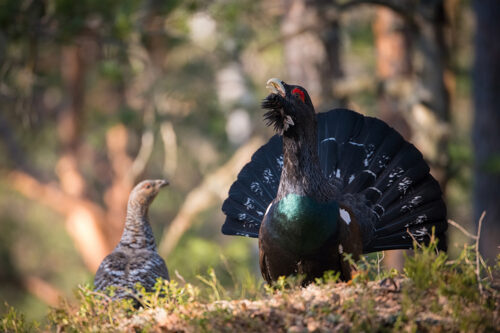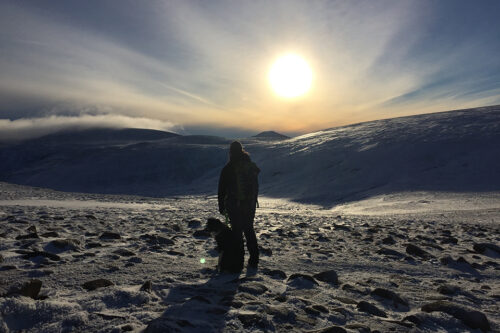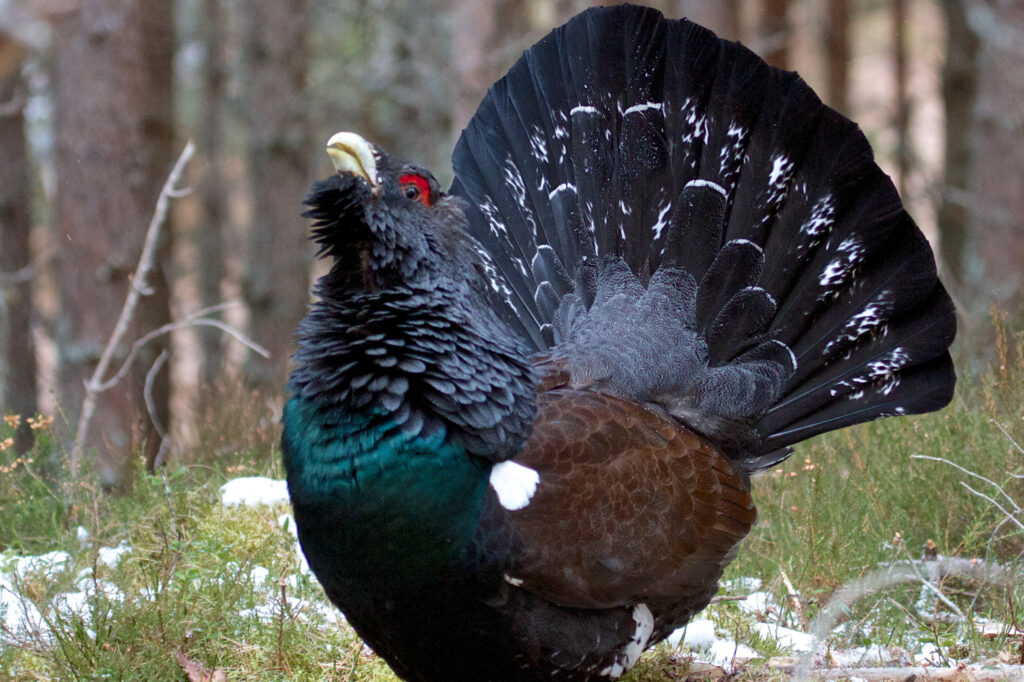Since 1985, the number of European Capercaillies in the Middle Bavarian Alps has been reduced by more than 60%. This has occurred despite a general hunting prohibition since 1973 and a reform of the administration of Bavarian forests in 2005. New research points to the influence of climate changes, as well as forest structures.

The capercaillie – or Tetrao urogallus – was a common breeding bird throughout most of our history. Essentially a relic from the Ice Age, it was common in our early pine forests throughout the Stone and Bronze Ages. However, it clearly became less common during the Iron and Middle Ages, when widespread deforestation and heath formation took place. In Eastern and Central Europe, as well as the Alps, Appenines, and other mountainous areas, the capercaillie was a luxury item avidly hunted by the elite. Cooked like any game bird with onions, apples, berries, wild mushrooms and roots, wine, and honey would be added to the spiced sauce. According to the Irish Vikings, it tasted good with mead. Together with gannets, storks, herons, sparrowhawks, grey partridges, pheasants, and cranes, the capercaillie would grace the tables in the lord’s hall.
The capercaillie is a true giant. The male bird can reach up to 100 cm and weigh 6 kg, while the females only reach 2.5 kg; about the size of a goose and a small duck. The most exciting thing about the capercaillies is, of course, the males’ plumage. With a green breast, brown wings, and white spots on its spread-out tail, it’s easily recognizable by its dance and its marvelous cackling and croaking call. While its closest relative, the black grouse, prefers heaths and boggy areas, capercaillies are fond of pine forests with bogs and older pine woods. However, these forests should ideally be grazed by large ungulates to create the varied and open landscapes providing both shelter and open “ballrooms,” as biologists tell us (Ludwig 2023).
The Bavarian Alps and The Schwarzwald are home to the last remaining metapopulations of Capercaillies in Germany.
In a new study, long-term data from the Bavarian Alps was brought together to answer the primary question about the long-term trend development of the Capercaillie population in the Alps. More precisely, the scientists evaluated spring censuses from a total of seventy courtship sites from the Werdenfelser Land, the central Mangfallgebirge, and the transition between the eastern Mangfallgebirge and the western Chiemgau Alps over almost 40 years. The average trend across the three areas studied corresponded to a significant annual decline of 1.86%, or 60% for the whole period. For the first 25 years, the dwindling numbers were gradual. After 2010, however, a continuous annual decline of 6.57% set in. The results coincide with many deserted courtship areas. These results correspond to continuing declines in Capercaillie ranges elsewhere. Although the capercaillie is not redlisted worldwide, it is a fine barometer of the combined stress induced by climate and outdoor tourism.
According to Ludwig and his group of researchers, silvicultural changes associated with rising temperatures are the primary cause, but also strongly increasing recreational pressure on the last Capercaillie refuges is likely related to the observed trends. In Bavarian research, the impact of “off-piste” winter sports is mentioned. Also, the public support of these sports, augmented by websites marking our off-piste trails, seems to have pushed the consumption of the wilderness to new heights. Despite prohibitions against people staying overnight as well as e-mountain biking, which are deemed to disturb the fowls in wintertime causing their premature death, these conclusions are confirmed by the results from Cairngorm in Scotland.
Mountain biking in Cairngorms

The Capercaillie is primarily associated with conifer woodlands in Scotland, especially mature Scots pine forests with an understory of heather, bilberry, and cowberry. In the 18th century, the capercaillie became extinct in Scotland, Ireland, and northern England, following extensive felling of pinewood habitats to establish grazing enclosures. However, in the 19th century, the bird was reintroduced in Scotland by landowners with an interest in shooting. In recent years, though, numbers have decreased.
The reasons for the recent reductions in numbers and range are poorly understood, but habitat deterioration, increased predation, fence collisions, and insect shortages in June seem to cause poor chick survival. Since the recent reduction in numbers, there has been a voluntary moratorium by landowners on shooting. However, as in Bavaria, there has been no sign that this has reversed the decline.
To a large extent, the experience of the capercaillies in Cairngorm National Park matches those from the Bavarian Alps. Here, the impact of outdoor activities on their “playgrounds” or “dancing grounds” serves as a reliable indicator that birds do actually inhabit a place. However, the conclusion is that capercaillies avoid mountain bike trails up to 500 meters on each side of a trail, while they only avoid 150 meters from a hiking path. In Cairngorm, this means that only 39% of the forests and 45% of the scrub areas are actually used by the birds, which have contributed to the region’s famous whisky, Capercaillie Scotch Whisky. Half of all dancing grounds were within these untouched areas, and 95% were less than 200 meters from the center of these untouched places. Hiking paths were deemed only half as disturbing.
Capercaillies in Croatia
Croatia is another location, where the Capercaillies are being helped along. In 2019 the Central European Breeding Centre Tetrijeb was officially opened, and in 2022, the project joined Rewilding Europe’s network.
SOURCES
Deutliche Rückgänge des Auerhuhns Tetrao urogallus
in den Bayerischen Alpen
Tobias Ludwig, Florian Bossert, Anton Kling, Franz Weindl and Helmut Ellrott
In: Ornithol. Anz. (2023) Vol 61
Mapping the distribution of outdoor activities to assess their impacts on capercaillie (Tetrao urogallus). Evidence from user-generated geographic information
By Leonie Schulz, and Martin Price
In: The 10th MMV Conference: Managing outdoor recreation experiences in the Anthropocene – Resources, markets, innovations
Red. Af: By Øystein Aas, Monica Breiby, Sofie K. Selvaag, Per-Ambjørn Eriksson, Brigithe og Børrestad)
Norwegian University of Life Sciences Faculty of Environmental Sciences and Natural Resource Management, Oslo 2021
ISSN 2535-2806
